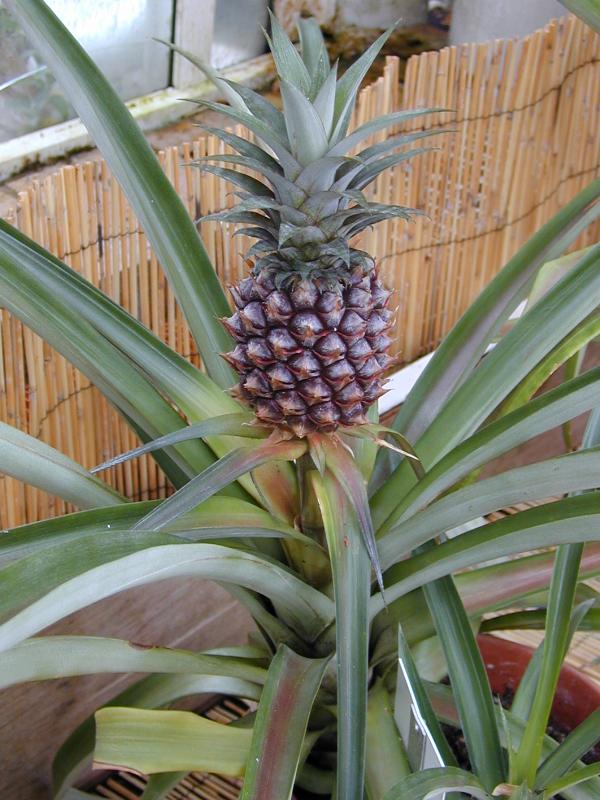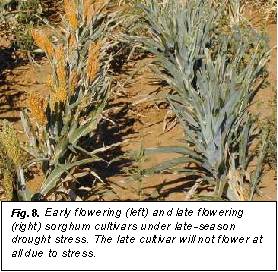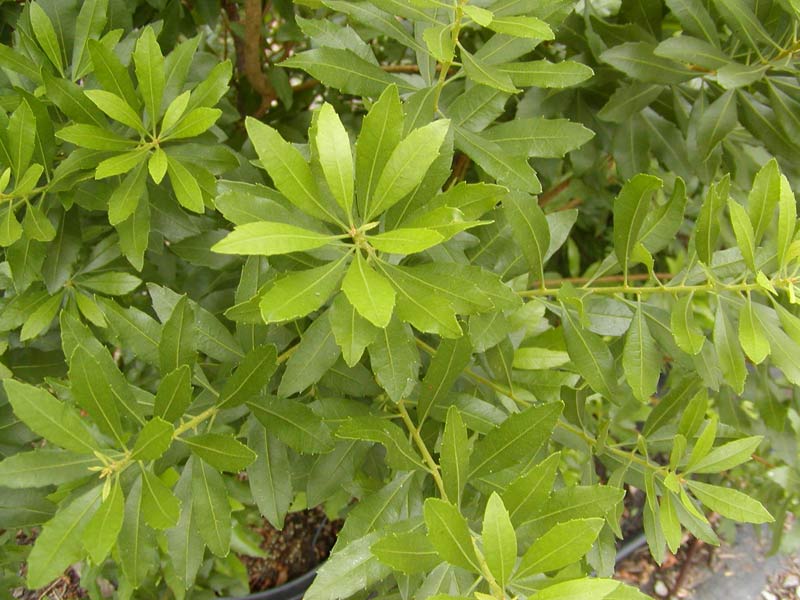
|
||
Stress Management ::Drought |
||
Response of Plants to Drought Stress Plants growing in drought stress may have the ability to control / avoid stress by escaping (Enduring Drought) or tolerating stress (by developing succulent or Non-succulent habit). These two capabilities are collectively termed as Drought Tolerance. i. Drought Evading Plants These plants remain under dormant / perennation to avoid stress period by seeds and shoots. Such plants complete their life-cycle in few weeks within the rainy season (eg. CO 16 variety of sorghum). They are called as Ephemerals. These plants also prolong their life cycle for some time based on the necessity. They reduce water loss by certain mechanism. ii. Succulents These (CAM) plants store enough water in their tissues. Their stomata open at night. They have thick leaves and possess modifications (such as phyllodes and phylloclades) under water stress conditions. They fix carbon during day time with the help of malic acid and CO2, which is released internally during respiration. iii. Non-succulents These plants endure drought with the following adaptive features:
Thus, because of these special features, succulents and non-succulents grow well under drought conditions. They are not or least affected by stress. Similarly, the arid zone plants also develop mechanisms to tolerate water stress, hence they are not adversely affected in terms of growth and yield. But, the non-arid zone plants suffer heavy loss in growth and yield because they do not have above said mechanisms to tolerate the stress. iv. Drought Resistant Plants These plants resist the water stress situations due to the following adaptive features / mechanisms. Therefore, these plants can be grown in drought facing / arid-zone areas.
Drought Resistance Mechanism The ability of a crop species or variety to grow and yield satisfactorily in areas subjected to periodic water deficits is termed as drought resistance Types of drought resistance
I. Drought Escape Two features of desert ephemerals that are important in drought resistance are
1. Rapid phonological development
Ability to produce flowers with a minimum of vegetative structure enables them to produce seeds on a limited water supply. 2. Developmental plasticity This feature enable the plants to produce an abundance of vegetative growth, flowers and seeds in seasons of abundant rain, enables the desert ephemerals to both escape drought and survive long periods without rain. In crop plants, the greatest advance in breeding for water limited environment is achieved by a shortening of life cycle, thereby allowing the crops to escape drought. Therefore, there is a strong consistent negative correlation between grain yield and days to first ear emergence and 40-90% variation in wheat yield under drought condition was accounted for by earliness. In wheat it was observed that drought resistance is greater in early lines than late ones even at the same intensity of drought. However, under adequate water supply, yield is often positively correlated with maturity date in determinate annual crops such as maize, sorghum and sunflower. An important aspect of developmental plasticity is the ability of plants to transfer assimilates accumulated prior to seed-filling to the grain during the seed filling stage. It was also suggested that when water supply is adequate only a small proportion of grain dry weight comes from the store of prior assimilate in the stems and roots, but when stress occurs in the seed filling stage, an increased proportion of the prior assimilate is transferred to the seed. To achieve the developmental plasticity, plants frequently have an indeterminate habit. This is an important survival mechanism in that it enables the large amounts of seed produced in wet years to carry the species through prolonged drought periods. Selection of rapid phonological development is the most rewarding approach in breeding for drought resistance in crops. In cereals, drought resistance varieties of wheat and barley flowered early than the others. However earliness is often negatively correlated with yield in year of adequate rainfall. II. Drought Tolerance at High Tissue Water Potential Ability of the plant to endure periods of drought by maintaining high tissue water potential. This mechanism is also called as drought avoidance. To maintain a high water status during a period of high evaporative demand / or increasing soil water deficit, the plant has two options. It must either reduce the water loss or maintain its supply of water. A. Reducing Water Loss i) Increased pubescence and ii) Increased leaf waxiness
B. Maintenance of water uptake i) Deeper root system ii) Hydraulic conductance of plants (increasing either the diameter of xylem vessels or their numbers). III. Drought Tolerance at low tissue water potential It is the ability of the plant to endure periods of drought and endure low tissue water potentials. This tolerance can be achieved by Desiccation Tolerance Based on the desiccation tolerance of the protoplasm, plants can be classified as poikilohydric or homohydric plants. 1) Poikilohydric (resurrection plants) The protoplasm of poikilohydric plants can withstand almost complete dehydration and can also withstand dehydration and rehydration in concert with available water without damage. 2) Homoiohydric plants Majority of the plants are homoiohydric plants. During growth and development, the protoplasm of homoiohydric plants cannot withstand low water potential without injury. Dehydration caused mechanical injury to the protoplast by physical tearing and destruction during water extraction and shrinkage. Small cells with no vacuoles and also the cells that lose their vacuoles and also the cells that lose their vacuoles during dehydration can withstand the most severe desiccation without mechanical injury. The changes in viscosity o the protoplasm and permeability of the membrane play a role in desiccation tolerance. It was also observed that cytoplasmic proteins are more stable to denaturation, coagulation or hydrolysis in desiccation resistant plants and that enzymes are less susceptible to inactivation by stress. RNA-DNA complex through which enzymes are manufactured is generally susceptible to desiccation and sugars play a role in protecting this mechanism in desiccation resistant species and varieties. Sugars may also provide protection against desiccation. Biochemical effect of drought tolerance 1) Accumulation of Proline, Glycinebetaines etc. 2) Synthisis of Abscisic acid (ABA) etc. |
||
| © All Rights Reserved. TNAU 2008-2024 |
||




